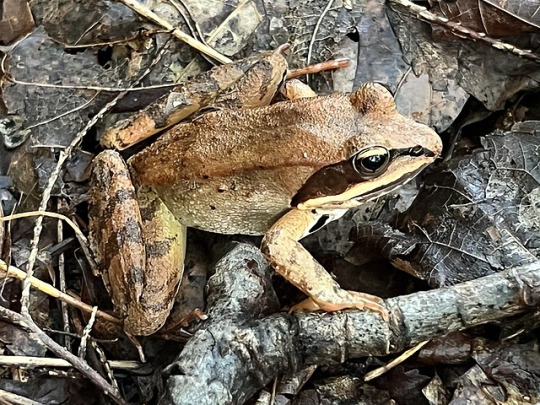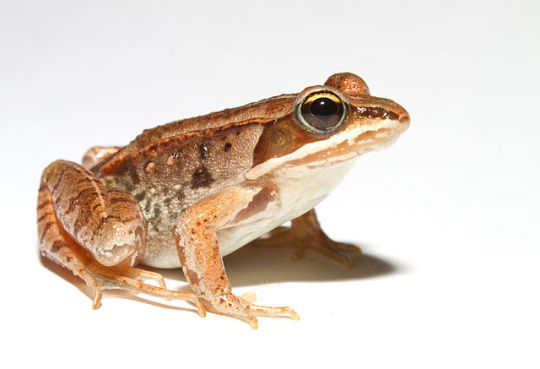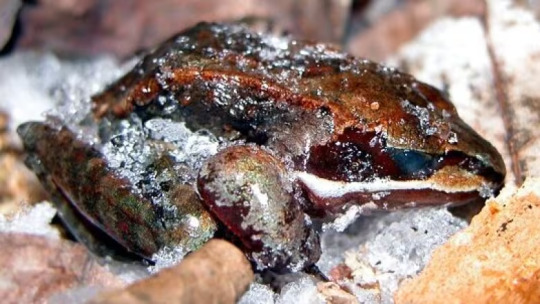#Wood Frog Rana sylvatica
Explore tagged Tumblr posts
Note
We love you Dr. Scherz!
Also, who else can I message on Tumblr to ask really weird and specific questions about frogs for my fantasy story?
I need a cold weather amphibian, specifically. While magical, it's much more fun to use something that somewhat exists in the real world and make it magical!
So, of the amphibians that survive in the cold weather, which of those live in foresty areas? And of those that are in there, how do they survive? What do they look like?
ARE THERE BIOLUMINESCENT FROGS???
Thanks! I don't really know who else would be suitable. I'll do my best to help.
There really are not a lot of cold-weather amphibians. I think you probably want Boreorana sylvatica (formerly Rana sylvatica or Lithobates sylvaticus), the Wood Frog. They live in forests and can freeze solid and thaw again when the cold passes.
Other than them, there is the European analog, Rana temporaria, and the Siberian salamander, Salamandrella keyserlingii. I do not know how these cope with the cold, but I imagine in a way very similar to B. sylvatica. You can read a bit about cold adaptations in the former in this paper, if you can get access to it (I am sure you can message the authors to ask for the paper and they will be happy to send you a free PDF—NEVER PAY THE PUBLISHER!).
No bioluminescent frogs, but there are quite a few that glow under UV. Boana punctata was the first to have this revealed, but it has since been found to be present in MANY amphibians. Additionally, some species have bones close enough to the surface to reveal the natural UV-fluorescence of their bones. Especially Brachycephalus toadlets have this.
Hope that helps!
264 notes
·
View notes
Text

WOOD FROG (rana sylvatica) - Composition Wednesday
© Erik McGregor - [email protected] - 917-225-8963
#PhotoOfTheDay#WoodgFrog#Ranasylvatica#amphibian#frog#TinyNature#frogs#amphibians#ForestFloor#EyeLevel#reptile#NYwildlife#AnimalEncounter#reptiles#wildlife#IntoTheTrees#IntoTheWoods#WalkInTheWoods#CharcoalBurnersTrail#AppalachianTrail#ClarenceFahnestockStatePark#NewYork#ReptilePhotography#AnimalPhotography#WildlifePhotography#NaturePhotography#ShotOnCanon#CanonPhotography#G5xMarkII#Photography
4 notes
·
View notes
Text
appreciation post for wood frogs

look

at

these

BABIES

AHHHHH

LIL MASKS
also during winter instead of just hibernating like other critters? these guys just

freeze
lil frogsicles
and then the spring comes and they melt and go back to being the little bouncy angels that they are
thank you for reading. bonus frog.

he’s learning how to frog still :,)
good night.
/don't tag this as goblincore/
#ari babbles#frog#frogs#frogblr#animals#wood frog#rana sylvatica#they BEANS#and i love them#sorry i'm really tired and just saw an extremely cute frog#god i love frogs
540 notes
·
View notes
Photo



Wood frog sex party at Conkle’s hollow!
10 notes
·
View notes
Text
Fun fact: Wood Frogs Survive Icy Winters via Frog-sicle status
The wood frog, Rana sylvatica, is scientifically referred to as “iconic” (source: Costanzo 2019).
The reason they are iconic is because they are famously able to freeze into a literal block of ice in the winter, remain frozen all season long, and then thaw out in the spring without any of the expected dying of cold! Incredible!

(you can recognise a wood frog by they lil mask by its eyes! Naturalists call it a raccoon mask, and honestly, 10/10 excellent raccoon disguise, completely indistinguishable)
I’ve known about this for years, because I spent a not-insignificant part of my childhood OBSESSED with frogs, but even 8-year-old me didn’t know that these frogs live north of the arctic circle.
That’s right! They live in Alaska! Where winter lasts more than seven months.
Wood frogs are actually the only amphibian in North America to live this far north. (there are a few species in Eurasia but THIS ISN’T ABOUT THEM 😉 source: x).

(I’m not saying Ohio wood frog are wimpy, but I AM calling them “““““delicate”””””. Image from Costanza 2019)
As winter approaches, wood frogs create little furrows in the forest floor, just big enough for them to wedge themselves into, and cover themselves with fallen leaves and other forest detritus (Costanza 2019). They then settle into their little shelter and begin to go through what I assume is a traumatizing experience.

(she loves a good furrow)
The furrow provides a small amount of insulation from the outside air, but even inside their shelter, it can get pretty cold.
In fact, wood frogs can survive temperatures as low as -16°C (3°F for the people who use the other system).
Generally, if you are a water-based organism, being exposed to temperatures so far below the freezing point is... bad. And if the water inside of a water-based organism freezes? That is Extra Bad.
Luckily, wood frogs have a foolproof way to stay safe: they are absolutely FULL of sugar and urine.

(I would have said “piss and vinegar” but the vinegar part is technically untrue 😔)
Specifically, the frog increases the concentration of urea in their body tissues before winter sets in. Urea, which is what urine is made of in humans, is commonly used by amphibians to protect themselves from losing too much water to the environment (Costanza 2019). However, wood frogs take it to the Extreme.
Additionally, as the frog begins to freeze, the liver begins to break down the glycogen stores that had been built up in advance, releasing high concentrations of glucose (aka sugar) into the bloodstream of the frog, (Costanza 2019).
By changing the properties of the internal fluid, the urea and glucose protect the frog’s cells from being damaged by ice, protecting various internal structures and even helping to regulate their metabolism (Costanza 2019).
(there’s also some stuff with nitric oxide and membrane adaptation but it’s A Lot and if you’re interested I recommend Constanza 2019. see bottom of post for references!)

(frog: *is flat and frozen*)
While frozen, the frog doesn’t need to eat, or even to breathe, because their metabolism is comes to a near-standstill. Their heart stops beating, and they can survive having up to 70% of it’s body fluids completely frozen (Costanza 2019).
There’s still a little bit of metabolic activity happening, just to keep the frog alive, but this allows the frog to live for months while frozen (nearly) solid until the spring melt comes!
The frog will generally stay in its little burrow for a few hours as it thaws, presumably processing the trauma of what just happened (also making a few physiological changes to survive the transition from ice cube to frog, I guess), before heading outside to immediately reproduce with the snowmelt.

(a photo of bliss)
This has been fun fact friday!
Hey y’all! As winter turns to spring, I wanted to do a little series of how animals survive cold, snowy winters when they are unable to migrate. Today was a frozen frog, and next I’ll talk about how turtles survive under the ice all winter long!
Stay tuned!
References under the read more
Smithsonian channel (2015) Frogsicles: Frozen but still alive. https://youtu.be/pLPeehsXAr4
Costanzo, J. P. (2019). Overwintering adaptations and extreme freeze tolerance in a subarctic population of the wood frog, Rana sylvatica. Journal of Comparative Physiology B, 189(1), 1-15. doi: 10.1007/s00360-018-1189-7
Kuzmin, S.L & Tessier, D.F. (2013) Amphibians and reptiles. In: Arctic Biodiversity Assessment 2013 http://www.arcticbiodiversity.is/index.php/the-report/chapters/amphibians-and-reptiles
Layne Jr, J. R., & First, M. C. (1991). Resumption of physiological functions in the wood frog (Rana sylvatica) after freezing. American Journal of Physiology-Regulatory, Integrative and Comparative Physiology, 261(1), R134-R137.
#biology#fun facts#science#sciblr#science side of tumblr#zoology#herpetology#physiology#winter#frogs#frog#fun fact friday#im on a new medication and it's so good u guyz :3
136 notes
·
View notes
Photo





Frogs - work in progress to completion.
#wood frog#Lithobates sylvaticus#Rana sylvatica#froggies#drawing#illustration#WIP#work in progress#illustrating#colored pencil#prismacolors#drawn on print
0 notes
Photo

Wood Frog Lithobates Sylvaticus Rana Sylvatica The most amazing thing about this frog is its ability to freeze during the winter and thaw out in the spring. Normally when a heart stops beating an animal is dead, but with the wood frog they can shut down their bodies including its heart and lungs and then defrost itself from within. It is still a scientific mystery on how the body reactivates. The study of this frog and other biological materials from below normal temperatures is called Cryobiology. Scientists believe if we can learn from the adaptation of the wood frog the knowledge could be used to help with medical problems such as freezing organs until needed and thawing them out for transplants without damage "Cryopreservation" Not only can they survive being frozen, they can be frozen and defrosted multiple times called freezing episodes and can withstand being frozen for up to 8 months a year normally in episodes of under four weeks at a time. Even though the frog is frozen on the outside it inhibits a Glucose which is sent to its cells which helps to protect it from getting completely frozen even though its heart is not beating and lungs not breathing. It can be frozen to up to 70% of its total fluids including its eyes and blood.
13 notes
·
View notes
Text
Save The Frogs Day April 29
Northern Leopard Frog compared to frogs around the world. Northern Leopard Frog lower right corner
Rana_sylvatica Wood Frog
Rana_pipiens Northern Leopard Frog
Lithobates_sylvaticus_(wood_frog)
“If we can discover the meaning in the trilling of a frog, perhaps we may understand why it is for us not merely noise but a song of poetry and emotion.” – Adrian Forsyth
In the plains and parkland region of Saskatchewan are several species of frogs which can be found around the wetlands, marshes, rivers, streams, and “prairie potholes.” The number of species observable increase during the cyclical years when Saskatchewan has a higher water table. Saskatchewan, experiences a temperate climate, which cycles between drought and high moisture years. Winnipeg locates at the confluence of the Red and Assiniboine Rivers. During the years when the Red River produces great floods through North Dakota, and Manitoba, those are also years when the water table is high in Saskatchewan and communities of Saskatchewan also experience flooding. Historically, there have been high water levels during the years 2011, 2009, 1997, 1996, 1979, 1974, and 1950.
Saskatchewan species of frogs include; Canadian Toad Anaxyrus hemiophrys, Great Plains Toad Bufo cognatus, Plains Spadefoot Toad Spea bombifrons, Boreal Chorus Frog Pseudacris maculata, Leopard Frog Rana pipiens, Wood Frog Rana sylvatica. Diane Secoy limits the The Plains spadefoot and Great Plains toad to the southwestern corner of Saskatchewan, the area formerly known as “Palliser’s Triangle.”
Biologists study the ecology, life history, osteology, and mating calls of the these amphibians. The evolutionary history is determined by examining the distributions, ecology, cranial osteology, and mating calls. In the field, colouration is noted, along with webbing between fingers, shape of the snout, size, distinctions of thighs, shape of vocal sac, shape of maxillary processes, for instance to determine geographic variations. The tadpoles are also examined for ventral fins, mating calls, colouration, tail, snout, teeth. Frogs do have an olfactory sense, and can sense chemical changes in the air. The presence of amphibians in an ecosystem, is a good indicator of the health of the biome. Tadpoles can use the chemical scents as a method to be aware of predators or food. The particular marsh, or wetlands area where a tadpole was born possesses its own unique perfume or scent, to which the frog is also drawn towards in the final life cycle. At the top of the frog’s mouth is the jacobson’s organ, which is how a frog detects scent. A frog will open and close their mouths to activate their jacobson’s organ in an effort to locate food.
On studying amphibians, not only is it important to reflect upon where are frogs, and toads in winter-time, but also where are frogs and toads in the summer-time during droughty years?
When discovering a Saskatchewan amphibian could you tell a toad from a frog?
Do you know what is the life cycle of a frog (or of a toad) as if related by the creature itself?
So what can you do on “Save The Frogs Day April 29?” The most important thing, would be to Learn about the Frogs of Saskatchewan!
For more information on species at risk or to participate in Stewards of Saskatchewan program offered by Nature Saskatchewan “Humanity in Harmony with Nature” please call 1-800-667-HOOT (1-800-667-4668)
“There were frogs all right, thousands of them. Their voices beat the night, they boomed and barked and croaked and rattled. They sang to the stars, to the waning moon, to the waving grasses. They bellowed long songs and challenges.” – John Steinbeck
BIBLIOGRAPHY: Canadian Biodiversity Species. Amphibians and Reptiles: Frogs and Toads (Anura)
frog smell.
Frogwatch. Saskatchewan. Learn about the Frogs of Saskatchewan!
Secoy, Diane Amphibians Encyclopedia of Saskatchewan. Canadian Plains Research Centre. University of Regina.2006
Species at Risk Public Registry. Northern Leopard Frog Western Boreal / Prairie populations Government of Canada.
Northern Leopard Frog compared to frogs around the world. Northern Leopard Frog lower right corner
Rana_sylvatica Wood Frog
Rana_pipiens Northern Leopard Frog
Lithobates_sylvaticus_(wood_frog)
For more information:
Richard St. Barbe Baker Afforestation Area is located in Saskatoon, SK, CA north of Cedar Villa Road, within city limits, in the furthest south west area of the city. Wikimapia Map: type in Richard St. Barbe Baker Afforestation Area Google Maps South West Off Leash area location pin at parking lot Web page: https://stbarbebaker.wordpress.com Where is the Richard St. Barbe Baker Afforestation Area? with map Facebook: StBarbeBaker Facebook group page : Users of the St Barbe Baker Afforestation Area Facebook: South West OLRA If you wish to support the afforestation area with your donation, write a cheque please to the “Meewasin Valley Authority Richard St. Barbe Baker Afforestation Area trust fund” (MVA RSBBAA trust fund) and mail it to Richard St. Barbe Baker Afforestation Area c/o Meewasin Valley Authority, 402 Third Ave S, Saskatoon SK S7K 3G5. Thank you kindly! Twitter: St Barbe Baker
Pinterest richardstbarbeb
The Trilling of a Frog Save The Frogs Day April 29 “If we can discover the meaning in the trilling of a frog, perhaps we may understand why it is for us not merely noise but a song of poetry and emotion.” – Adrian Forsyth…
#amphibians#Boreal Chorus Frog Pseudacris maculata#Canadian Toad Anaxyrus hemiophrys#drought#frogs#Great Plains Toad Bufo cognatus#Leopard Frog Rana pipiens#marshes#parkland#plains#Plains Spadefoot Toad Spea bombifrons#toads#wetlands#Wood Frog Rana sylvatica
0 notes
Text
Frogs form 'boy bands' and sing together to woo females into their pools, study finds | Daily Mail Online
0 notes
Photo

So, I drew Sirus’ pet frog! With vacation happening in like.. six days, I’m filling my missed play time with character dev and details. Dannifen’s featured in a few rps thus far. So, I figured I really ought to fill out some details about him.
I’m basing him off of the Rana Sylvatica, which can be found as far north as Alaska, and survives the winters very well. Gonna call it a northern wood frog.
Also, i chose middle names for sirus and dwen. XD
Sirus Alexandre-Stoussaint Shadowstar
&
Ceridwen Idenne-Elainne Shadowstar
5 notes
·
View notes
Text
Rana Sylvatica - wood frog that freezes in winter. possible name?
0 notes
Photo

I recently started taking pictures of some of south east Manitoba's more common amphibian species, to aid people with identification. Here's a Wood Frog (Rana [Lithobates] sylvatica) — — — #manitoba #canada #exploremb #explorecanada #conservation #herps #herping #animals #wildlife #nature #photography #amphibian #frog #studio #fall (at Winnipeg, Manitoba)
#photography#animals#herps#nature#canada#herping#manitoba#explorecanada#wildlife#frog#studio#exploremb#fall#amphibian#conservation
0 notes
Photo

A wood frog(rana sylvatica) is my best guess
0 notes
Text
Microsatellite variation and fine-scale population structure in the wood frog (Rana sylvatica)
http://dlvr.it/NHdfTt
0 notes
Text
Frogs form 'boy bands' and sing together to woo females into their pools, study finds | Daily Mail Online
0 notes
Text
Frogs form 'boy bands' and sing together to woo females into their pools, study finds | Daily Mail Online
0 notes